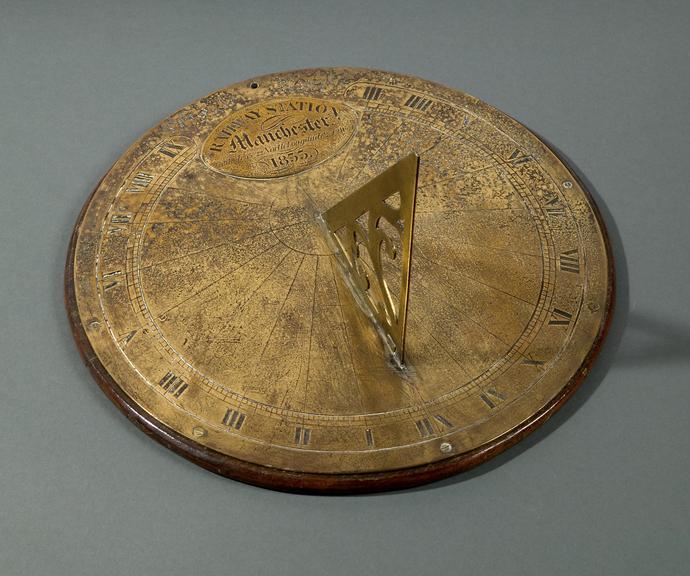The sundial that was chosen by the BBC for their Civilisations app has been a feature of Liverpool Road Station for over 180 years, and an object of fascination for over a century. Early tourism to Liverpool Road Station is an aspect of my PhD research that I’ve found quite surprising; I previously thought of it as a working station and then a museum from 1983 onwards. Yet ad hoc, unofficial tourism began as early as the 1910s and took place regularly from the 1930s to 1960s.

Photographed on display in the Revolutionary Railroad gallery.
Science Museum Group © The Board of Trustees of the Science Museum
Staff at Liverpool Road became so accustomed to visitors, objects from Liverpool and Manchester Railway were compiled into a ‘museum of relics’. Items included a stone sleeper from the railway line and the station bell (pictured above). According to former station staff, in 1929 the sundial was removed from a plinth outside and placed in the offices of Grundy, the goods agent at the station until 1931. The sundial featured in the Liverpool Echo in 1937, photographed outside with a member of staff. We next see it in a 1939 Pathé film, Oldest Railway Station, again displayed outside in front of the track. This short factual film shows the role of the station as a Manchester curiosity.
During the Second World War, the sundial was taken down, presumably for safety reasons. The Water Street end of the station was bomb damaged during the Manchester Christmas Blitz, affecting stables and staff rooms under the railway arches. The sundial was rediscovered with other relics during the installation of a new canteen in 1943. 12 years later, in 1955, a reporter for The Manchester Guardian was shown the sundial, as well as old clerk’s desks and historic documents from the railway. The relics became a talking point for railway enthusiasts, such as members of the Stephenson Locomotive Society, who began the ‘Old Manchester Rail Tour’ at the station on 12 May 1956. Goods agent, Mr Weaver, showed the Society the original booking hall and waiting rooms: ‘here relics displayed in the main office, itself part of the 1830 buildings, included the station sundial of 1833’.

Science Museum Group © The Board of Trustees of the Science Museum
Freight operations at Liverpool Road wound down from 1968 onwards, with a skeleton service continuing to 1975. By this time, most of the station was derelict and suffered from vandalism. The historic sundial and station bell were removed by British Rail for safekeeping. By 1980, the station was set to become the Greater Manchester Museum of Science and Industry. British Rail returned the relics for the 150th anniversary of the Liverpool and Manchester Railway, which was marked by a ‘Great Railway Exposition’ in August and September 1980. The objects stayed at the Museum and remain two of the most important objects from the original Liverpool Road Station in MSI’s collection.
One comment on “Relics of the railway”
Comments are closed.